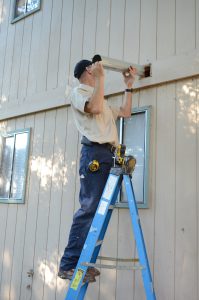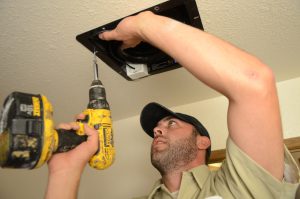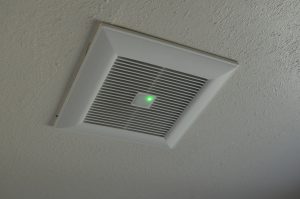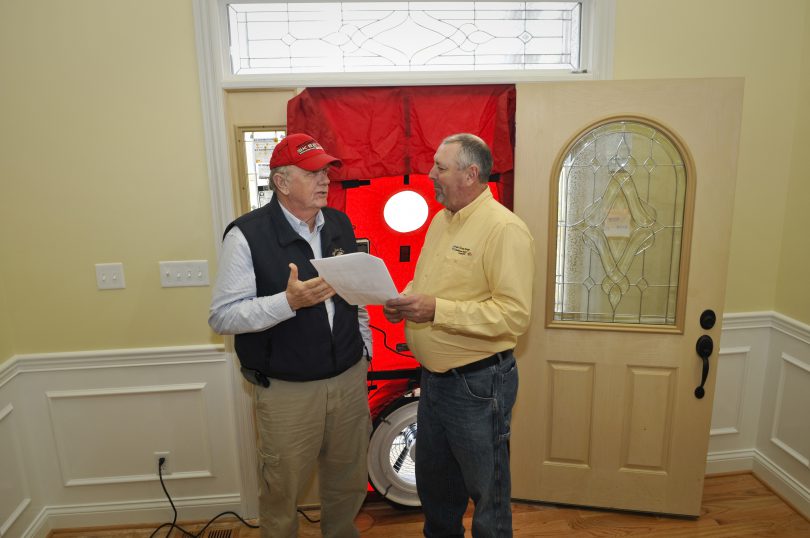By Patrick Keegan and Amy Wheeless
Sealing air leaks is usually one of the best energy efficiency investments a homeowner can make. A typical home leaks, on average, about half of its air every hour, which is like having your kitchen window open all day, every day. Sealing air leaks can also eliminate drafts that keep your home from being cozy.

Controlled ventilation is more reliable than random air leaks for consistent, quality indoor air. Photo Credit: Weatherization Assistance Project Technical Assistance Center.
However, it is possible to seal up some homes so “tight” that they have little ventilation, which can contribute to indoor air quality problems or a build-up of moisture. The challenge is to achieve the best home performance and energy savings while maintaining air quality. The first step to take is to eliminate or reduce indoor air pollutants, such as smoke or chemicals. Experts then recommend sealing air leaks as much as possible and installing mechanical ventilation, as needed. Simple mechanical ventilation can be controlled and consistent, as opposed to “natural” ventilation from air leaks, which can result in a home being too drafty in more extreme weather and not ventilated enough in milder weather.

Your home performance contractor can work with you to determine whether whole house ventilation is needed. Photo Credit: Weatherization Assistance Project Technical Assistance Center.
The best way to inspect your home for air leaks is to hire a contractor or energy auditor who will conduct a blower door test, which uses a powerful fan to measure the air infiltration rate. During the test, the contractor will locate and seal air leaks. After sealing, the contractor can measure the resulting air infiltration rate and talk with you about any ventilation needs. There is no simple way to determine how much mechanical ventilation your home will need — it depends on a combination of factors, including the rate of air flow into your home, what kind of climate you live in, the layout and occupancy of your home and whether there are other indoor air quality concerns, such as radon or combustion appliances like gas furnaces.
Mechanical ventilation systems allow for controlled air movement and a rate of ventilation in your home on which you can depend, helping ensure good indoor air quality and appropriate levels of moisture. Generally, newer homes that have been sealed well and manufactured homes have the greatest need for mechanical ventilation.

Spot ventilation, like bathroom fans, focuses on removing moisture and indoor air pollutants at their source. Photo Credit: Weatherization Assistance Project Technical Assistance Center.
There are two primary categories of mechanical ventilation. Many people are familiar with spot ventilation systems. These are the fans that you find above your oven range, in your laundry room, in your bathroom and perhaps above a garage workshop. They focus on removing moist air and indoor air pollutants at the source. Generally, these fans only work when you turn them on, but you can install condensation sensors or humidistats so the fans will turn on whenever they sense a higher moisture content in the air. Keep in mind, running these fans constantly can take too much heated or cooled air out of your home, increasing your energy bills.
Whole-house ventilation circulates air throughout the home and introduces the right amount of outside air. There are four categories of whole-house ventilation systems; determining which method is best for you will depend on your home’s needs, budget and climate:
• Exhaust ventilation systems: Fans pull air out of your home, which increases infiltration from the outside, either through air leaks or vents.
• Supply ventilation systems: Fans bring outside air into your home.
• Balanced ventilation systems: Both supply and exhaust fans circulate air in and out of the home.
• Energy recovery ventilation systems: Fans, combined with heat exchangers, modulate the temperature and humidity of incoming air into your home.
Talk with your energy auditor or home performance contractor about whether you need additional mechanical ventilation, and if so, which system would work best for your living space.
This column was co-written by Pat Keegan and Amy Wheeless of Collaborative Efficiency.

